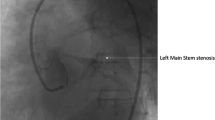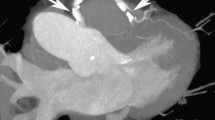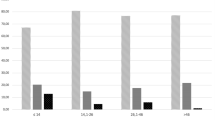Abstract
Coronary sequelae of Kawasaki disease, post-surgical coronary lesions and cardiac allograft vasculopathy are the main causes of acquired coronary pathology in childhood. Surveillance and timely recognition of coronary problems in children who are at risk of ischemic events are imperative and noninvasive imaging is increasingly utilized for these purposes. Herein, we summarize the causes of acquired coronary disease in children and discuss the role of various imaging techniques that are available to establish the diagnosis and guide management.





Similar content being viewed by others
Abbreviations
- ALCAPA:
-
Anomalous left coronary artery from pulmonary artery
- CMRI:
-
Cardiac magnetic resonance imaging
- CCT:
-
Cardiac computed tomography
- IVUS:
-
Intravascular ultrasound
- PET:
-
Positron emission tomography
- SSFP:
-
Steady state free precession
- TGA:
-
Transposition of the great arteries
References
Goo (2011) Cardiac MDCT in children: CT technology overview and interpretation. HW Radiol Clin North Am 49:997–1010
McCrindle BW, Li JS, Minich LL et al (2007) Coronary artery involvement in children with Kawasaki disease: risk factors from analysis of serial normalized measurements. Circulation 116:174–179
Research Committee on Kawasaki Disease (1984) Report of subcommittee on standardization of diagnostic criteria and reporting of coronary artery lesions in Kawasaki disease. Japanese Ministry of Health and Welfare, Tokyo
Margossian R, Lu M, Minich LL et al (2011) Predictors of coronary artery visualization in Kawasaki disease. J Am Soc Echocardiogr 24:53–59
Newburger JW, Takahashi M, Gerber MA et al (2004) Diagnosis, treatment, and long-term management of Kawasaki disease: a statement for health professionals from the Committee on Rheumatic Fever, Endocarditis and Kawasaki Disease, Council on Cardiovascular Disease in the Young, American Heart Association. Circulation 110:2747–2771
Goo HW, Park IS, Ko JK et al (2006) Coronary CT angiography and MR angiography of kawasaki disease. Pediatr Radiol 36:697–705
Arnold R, Ley S, Ley-Zaporozhan J et al (2007) Visualization of coronary arteries in patients after childhood Kawasaki syndrome: value of multidetector CT and MR imaging in comparison to conventional coronary catheterization. Pediatr Radiol 37:998–1006
Greil GF, Seeger A, Miller S et al (2007) Coronary magnetic resonance angiography and vessel wall imaging in children with Kawasaki disease. Pediatr Radiol 37:666–673
Carbone I, Cannata D, Algeri E et al (2007) Adolescent Kawasaki disease: usefulness of 64-slice CT coronary angiography for follow-up investigation. Pediatr Radiol 41:1165–1173
Tacke CE, Kuipers IM, Groenink M et al (2011) Cardiac magnetic resonance imaging for noninvasive assessment of cardiovascular disease during the follow-up of patients with Kawasaki disease. Circ Cardiovasc Imaging 4:712–720
Strigl S, Beroukhim R, Valente AM et al (2009) Feasibility of dobutamine stress cardiovascular magnetic resonance imaging in children. J Magn Reson Imaging 29:313–319
Goo HW, Yang DH (2010) Coronary artery visibility in free-breathing young children with congenital heart disease on cardiac 64-slice CT: dual-source ECG-triggered sequential scan vs. single-source non-ECG-synchronized spiral scan. Pediatr Radiol 40:1670–1680
Paul JF, Rohnean A, Elfassy E et al (2011) Radiation dose for thoracic and coronary step-and-shoot CT using a 128-slice dual-source machine in infants and small children with congenital heart disease. Pediatr Radiol 41:244–249
Kroft LJ, Roelofs JJ, Geleijns J (2010) Scan time and patient dose for thoracic imaging in neonates and small children using axial volumetric 320-detector row CT compared to helical 64-, 32-, and 16- detector row CT acquisitions. Pediatr Radiol 40:294–300
Sorantin E, Riccabona M, Stücklschweiger G et al (2012) Experience with volumetric (320 rows) pediatric CT. Eur J Radiol. Jan 5. [Epub ahead of print]
Miéville FA, Gudinchet F, Rizzo E et al (2011) Paediatric cardiac CT examinations: impact of the iterative reconstruction method ASIR on image quality-preliminary findings. Pediatr Radiol 41:1154
Newman B, Vasanawala SS (2011) Point/counterpoint: dose-related issues in cardiac CT imaging. Pediatr Radiol 41(Suppl 2):528–533
Legendre A, Losay J, Touchot-Kone A et al (2003) Coronary events after arterial switch operation for transposition of the great arteries. Circulation 108(Suppl 1):II186–II190
Bonnet D, Bonhoeffer P, Piechaud JF et al (1996) Long-term fate of the coronary arteries after the arterial switch operation in newborns with transposition of the great arteries. Heart 76:274–279
Bonhoeffer P, Bonnet D, Piechaud JF et al (1997) Coronary artery obstruction after the arterial switch operation for transposition of the great arteries in newborns. J Am Coll Cardiol 29:202–206
Tanel RE, Wernovsky G, Landzberg MJ et al (1995) Coronary artery abnormalities detected at cardiac catheterization following the arterial switch operation for transposition of the great arteries. Am J Cardiol 76:153–157
Ou P, Mousseaux E, Azarine A et al (2006) Detection of coronary complications after the arterial switch operation for transposition of the great arteries: First experience with multislice computed tomography in children. J Thorac Cardiovasc Surg 131:639–643
Ou P, Celermajer DS, Marini D et al (2008) Safety and accuracy of 64-slice computed tomography coronary angiography in children after the arterial switch operation for transposition of the great arteries. JACC Cardiovasc Imaging 1:331–339
Hauser M, Bengel FM, Kuhn A et al (2001) Myocardial blood flow and flow reserve after coronary reimplantation in patients after arterial switch and Ross operation. Circulation 103:1875–1880
Yates RW, Marsden PK, Badawi RD et al (2000) Evaluation of myocardial perfusion using positron emission tomography in infants following a neonatal arterial switch operation. Pediatr Cardiol 21:111–118
Rickers C, Sasse K, Buchert R et al (2000) Myocardial viability assessed by positron emission tomography in infants and children after the arterial switch operation and suspected infarction. J Am Coll Cardiol 36:1676–1683
Taylor AM, Dymarkowski S, Hamaekers P et al (2005) MR coronary angiography and late-enhancement myocardial MR in children who underwent arterial switch surgery for transposition of great arteries. Radiology 234:542–547
Taylor AM, Thorne SA, Rubens MB et al (2000) Coronary artery imaging in grown up congenital heart disease: complementary role of magnetic resonance and X-ray coronary angiography. Circulation 101:1670–1678
Li D, Kaushikkar S, Haacke EM et al (1996) Three-dimensional MR imaging with retrospective respiratory gating. Radiology 201:857–863
Jahnke C, Paetsch I, Nehrke K et al (2005) Rapid and complete coronary arterial tree visualization with magnetic resonance imaging: Feasibility and diagnostic performance. Eur Heart J 26:2313–2319
Spuentrup E, Bornert P, Botnar RM et al (2002) Navigator-gated free-breathing three-dimensional balanced fast field echo (TrueFISP) coronary magnetic resonance angiography. Invest Radiol 37:637–642
Weber OM, Martin AJ, Higgins CB (2003) Whole-heart steady-state free precession coronary artery magnetic resonance angiography. Magn Reson Med 50:1223–1228
Niendorf T, Hardy CJ, Giaquinto RO et al (2006) Toward single breath-hold whole-heart coverage coronary MRA using highly accelerated parallel imaging with a 32-channel MR system. Magn Reson Med 56:167–176
Kefer J, Coche E, Legros G et al (2005) Head-to-head comparison of three-dimensional navigator-gated magnetic resonance imaging and 16-slice computed tomography to detect coronary artery stenosis in patients. J Am Coll Cardiol 46:92–100
Azakie A, Russell JL, McCrindle BW et al (2003) Anatomic repair of anomalous left coronary artery from the pulmonary artery by aortic reimplantation: early survival, patterns of ventricular recovery and late outcome. Ann Thorac Surg 75:1535–1541
Isomatsu Y, Imai Y, Shin’oka T et al (2001) Surgical intervention for anomalous origin of the left coronary artery from the pulmonary artery: the Tokyo experience. J Thorac Cardiovasc Surg 121:792–797
Alexi-Meskishvili V, Nasseri BA, Nordmeyer S et al (2011) Repair of anomalous origin of the left coronary artery from the pulmonary artery in infants and children. J Thorac Cardiovasc Surg 142:868–874
Secinaro A, Ntsinjana H, Tann O et al (2011) Cardiovascular magnetic resonance findings in repaired anomalous left coronary artery to pulmonary artery connection (ALCAPA). J Cardiovasc Magn Reson 13:27
Di Filippo S, Semiond B, Roriz R et al (2003) Non-invasive detection of coronary artery disease by dobutamine-stress echocardiography in children after heart transplantation. J Heart Lung Transplant 22:876–882
Romeo G, Houyel L, Angel CY et al (2005) Coronary stenosis detection by 16-slice computed tomography in heart transplant patients: comparison with conventional angiography and impact on clinical management. J Am Coll Cardiol 45:1826–1831
Rohnean A, Houyel L, Sigal-Cinqualbre A et al (2011) Heart transplant patient outcomes: 5-year mean follow-up by coronary computed tomography angiography. Transplantation 91:583–588
Summers RM, Andrasko-Bourgeois J, Feuerstein IM et al (1998) Evaluation of the aortic root by MRI: insights from patients with homozygous familial hypercholesterolemia. Circulation 98:509–518
Stamm C, Friehs I, Ho SY et al (2001) Congenital supravalvar aortic stenosis: a simple lesion? Eur J Cardiothorac Surg 19:195–202
Bonnet D, Cormier V, Villain E et al (1997) Progressive left main coronary artery obstruction leading to myocardial infarction in a child with Williams syndrome. Eur J Pediatr 156:751–753
Sun CC, Jacot J, Brenner JI (1992) Sudden death in supravalvular aortic stenosis: fusion of a coronary leaflet to the sinus ridge, dysplasia and stenosis of aortic and pulmonic valves. Pediatr Pathol 12:751–759
Thistlethwaite PA, Madani MM, Kriett JM et al (2000) Surgical management of congenital obstruction of the left main coronary artery with supravalvular aortic stenosis. J Thorac Cardiovasc Surg 120:1040–1046
Conflicts of interest
None.
Author information
Authors and Affiliations
Corresponding author
Electronic supplementary material
Below is the link to the electronic supplementary material.
2D-echocardiography in a 9-month-old child who had Kawasaki disease at the age of 6 weeks. There are patent motion abnormalities in the three apical views and parasternal short axis view at the level of papillary muscles (MPEG 430 kb)
Rights and permissions
About this article
Cite this article
Ou, P., Kutty, S., Khraiche, D. et al. Acquired coronary disease in children: the role of multimodality imaging. Pediatr Radiol 43, 444–453 (2013). https://doi.org/10.1007/s00247-012-2478-z
Received:
Revised:
Accepted:
Published:
Issue Date:
DOI: https://doi.org/10.1007/s00247-012-2478-z




